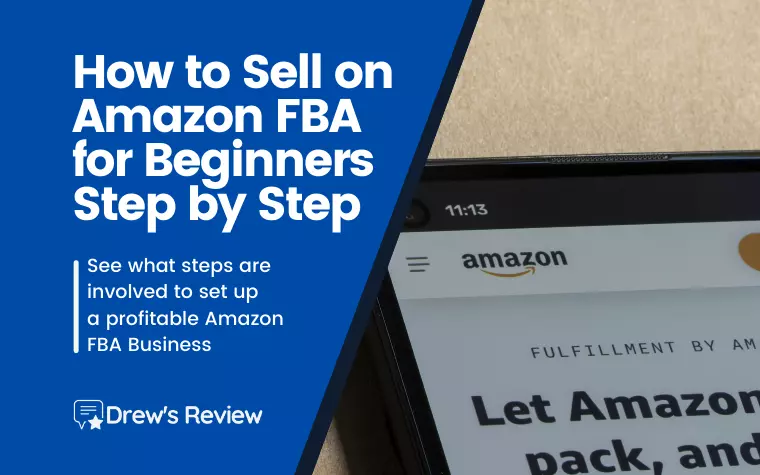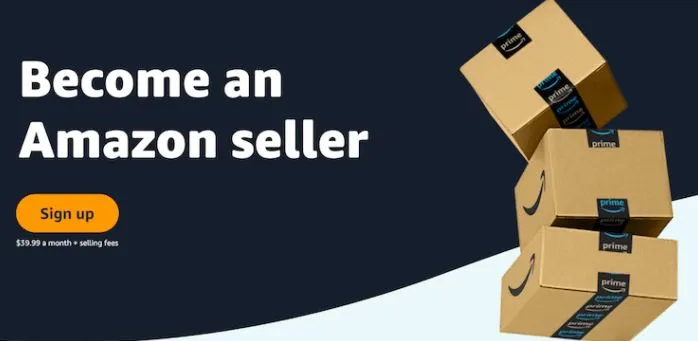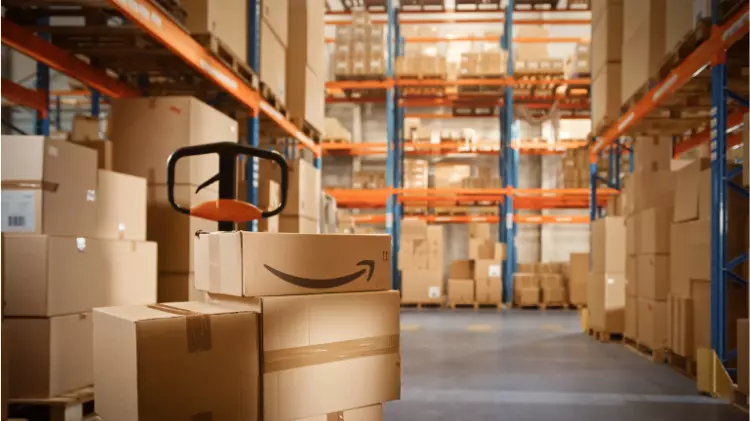
If you are new to selling on Amazon FBA, this blog post will help get you started. We’ll walk you through the steps of becoming an Amazon seller and give you some tips for setting up your first product listing.
You can make money online by using the fulfillment services of amazon.com. You will sell products that you get from manufacturers or wholesalers at a price that is much cheaper than retail prices.
FBA (Fulfillment by Amazon FBA) can be a complicated process but this guide will walk you through the fundamentals. How do I find a product? How do I find suppliers? How much money can I make?
This article will answer these questions and more, providing tips on how to sell on Amazon FBA for beginners in a step-by-step fashion.
What is Amazon FBA
Amazon FBA is also known as “Fulfillment by Amazon.” This often-used term refers to the method of fulfilling your orders by sending them directly to Amazon. Amazon will then send the product to customers on your behalf.
You pay Amazon FBA fees, but you do not have to worry about finding customers or packing orders. You send the product in bulk straight to Amazon, and then they take care of the rest!
How to Sell on Amazon FBA for Beginners Step by Step
Below is a guide on how you can start selling on Amazon as a complete beginner. Many ordinary people from all walks are Amazon sellers and some make a staggering 6 figures a month doing this.
Step 1: Choose Your Niche
In order to be successful with your Amazon business, you need to choose the right niche. This is incredibly important!
If you are starting out, you should choose something that has good demand, but low competition. This way, you will be able to rank in the search results more easily. Good options include products like clothing, shoes, and jewelry as long as there’s not too much competition for these niches.
You should also look at the types of competitors selling in your chosen niche. If they all have 4 or 5-star ratings, then it will be difficult to compete with them on product quality alone. However, if many of them have 2-star ratings or worse there’s a lot less competition when it comes to review count!
Additionally, avoid choosing extremely saturated markets when just starting out with FBA. This is because you will have a harder time competing against more established brands that sell at a lower price. You can still do this, but if you really want to be successful, go for something with lower competition.
Before moving on from this step, it’s important to note that most of the things mentioned above can be used as criteria when sourcing products as well! So keep these tips in mind!
Step 2: Source Products to Sell & Find Suppliers
Choosing the right product is crucial to your Amazon FBA business. If you want to sell on Amazon, it’s important to be able to source products fairly easily. This is where you will find products to private label. Private labeling means finding an existing product where you are allowed to put your own brand (label) on it. These are available from a plethora of third-party sellers.

Besides private labeling, you can also sell branded items from exclusive manufacturers. This involves dealing directly with the manufacturer bypassing the middleman. This also means you don’t have to private label anything. The advantage here is that people will recognize the brand you are selling. One course that teaches this well is The Wholesale Formula.
You should focus on these criteria when choosing a product:
1. Demand: Is this product in demand and can you find a supplier that is ready to produce it?
2. Availability: Does the product meet Amazon’s requirements (size, weight, dimensions)? Not all products will be accepted in Amazon FBA.
3. Profit margin: Look at the profit margin in relation to the price of the product. You might want to sacrifice margins in order to make more sales especially if the market is competitive
4. Price elasticity: Does this product have an elastic demand?
5. Competitive landscape: Who are your competitors for this product? Do they offer better prices than you do?
6. Supplier rate & quality: How much does it cost when you order from the supplier? Can you order in bulk to save on shipping costs? Is your supplier reliable?
7. Seasonal nature of the product: This is especially important for the clothing category. You need to ensure that there are no slow seasons for this product if it’s a seasonal item.
8. Import barriers/regulation: Can you import this product freely into Amazon FBA to be sold on their platform?
9. Weight & volume restrictions: Ensure that your product meets Amazon weight & dimensions requirements so that shipping fees will not eat up all your profits.
10. Shipping time & cost: How long does it take for your supplier to ship the item once you place your order? The shorter, the better!
What to Look for in Suppliers
There are a few things that you should be looking for when sourcing suppliers. When you’re dealing with a supplier, it’s important to note their location and whether they can ship to your destination country.
It’s also crucial to take a close look at the types of products they offer and how quickly their manufacturing process is. You should also make sure that they have a solid payment method in place, as well as reasonable prices for shipping the items from their country to yours.
Other things you should ask about include whether or not they have all of the certifications required by Amazon as well as any other company that may sell your product.
Step 3: Create Your Brand Name
Once you can source your products, you need to create a brand revolving around your products and business goals. Choose a name that is easy to remember, isn’t very long and most important – is different from everyone else. It doesn’t necessarily have to match the products you are listing, but it should represent your business.
For example, if your focus is on beauty products, you want a name that reflects beauty. You can use Shopify’s business name generator to help with that. Lastly, make sure you have the .com version of your brand name so that you can register it.
Here are other tips to consider when creating your brand:
Create Your Brand Logo
You will need an original branding logo for your new company or product line. You can hire a graphic artist, do it yourself or find one for cheap on places like Fiverr.
Branding Video
A branding video is a great way to show people who your business is and what you sell. This branding video will also play on Amazon for the customer when they scroll through their product listings. A branding video can be a huge advantage to your product and help you separate yourself from the competition. This branding video should have a professional feel, but not be too flashy.
Step 4: Create Your Amazon Seller Account

Here’s how to create your seller account:
Choose an account type
To open a seller account, you have to choose between an individual or a professional seller. An individual seller is free but charges $0.99 for each item sold so it’s only ideal if you plan on selling less than 40 items per month. A professional seller costs $39.99 per month but has no commission fees so it’s only worth the money if you plan on selling more than 40 items per month. Click either “Individual” or “Professional” depending on which account type you want to have*.
*Note: If your seller account becomes inactive, Amazon will charge a fee of $1 per month to keep your seller account active. If your seller account becomes inactive for 9 months then Amazon will delete your account, seller fees included.
Add FBA to your account
Keep in mind that you can’t create an FBA account until you set up your Seller account. The seller account is the base of your entire Amazon seller business so you have to make sure everything else is in place.
To add FBA, head over to the seller central dashboard and select “Inventory” from the menu on the left side. From there, click “Manage FBA Inventory” and then “Create a shipment.” You will need to input all of the necessary information about your product’s dimensions and weight for Amazon to ship them correctly.
Step 5: How to Ship Your Product to Amazon
Once your Amazon FBA Account is set up and you’ve got your product ready to go with the seller, it’s time to ship your product to the Amazon fulfillment center. You are going to need a good shipping plan.
You have a few shipping options:
1. Ship the items yourself from your location to Amazon using a shipping company like FedEx or UPS.
2. Have your supplier send the products directly from their location to Amazon’s fulfillment warehouse with shipping companies like DHL, USPS, or China Post.
3. Fulfill orders by shipping them from your own location to customers’ locations if they’re located in the same country as you – this is probably the most complex shipping method and will require more labor on your part because you’ll need to track everything personally and make sure no mistakes are made in transit. If an order somehow gets lost during shipping, you’ll be liable for replacing it.
Step 6: Create your product listing and Optimize it
Now that you have got your branding down, have your products, and are in the process of shipping them to Amazon, you will need to create your product listing. Your product listings should include optimized titles, descriptions, keywords, and images.
Before you create your product listing on Amazon it’s important to understand the Amazon search engine. Search engines are designed to mimic real-life searches people make in their day-to-day lives. For example, when people want to buy a new smartphone they might use Google or Bing to find what they are looking for. The same principle applies when people are shopping on Amazon only that the search volume is much higher than Google or Bing because Amazon is used worldwide by both consumers and businesses alike.
Product Titles
To create a well-optimized product listing, product titles should have a professional feel but not be too flashy. Product titles should draw the attention of a customer from their Amazon search to your product. You can do so by placing some clear, unique, and identifying information to draw potential customers to your product.
A trick you can apply is searching for similar products sold on Amazon and seeing how they list their product titles. Also, don’t forget to put one keyword in your product title.
Here’s an example: VISION ZS6 1080P Full HD Sports Action Camera. I’ve included our main keywords “Vision” and “ZS6”.
Product Description
Your product description should include everything that the customer would normally look for. This would include sizes, colors, weight, dimensions, features, installation guides or anything else that would be applicable.
Images
The first thing your customer sees is the photo of your product. You don’t want to have blurred or poorly taken photos. If you have to hire a professional to do this, it would be worth the money. However, you can always just use your smartphone to take great pics as long as you’ve got the right angle, lighting, and background. Most people won’t need a professional photographer.
Step 7: Inventory Management

To manage your inventory properly, it’s important to know your inventory turnover rate and how much inventory is needed to maintain that.
Your Inventory Turnover Rate (ITR) is calculated by dividing the number of units sold into the total number of units available for sale. For example, if you sell out 10 units then your ITR is 100%.
There are inventory management tools that can help you track everything rather than doing it on your own. Tools like SoStocked can help you with forecasting, over & under-ordering, tracking orders, managing bundles, and more.
Step 8 – The Importance of Customer Reviews
Customer reviews for your Amazon business are so important because they impact your visibility in search results. If you have a lot of negative reviews it will negatively affect your product ranking and in some cases, may cause you to lose business.
Here’s an example: “This is the worst chocolate ever! It tastes like cardboard with a hint of salt!”
Customers tend to trust other customers when doing an online purchase. They also tend to trust the few top-ranked businesses more than a business with a lot of positive reviews who are further down in the search results.
Don’t be afraid to ask your customers to leave a review. If you have a good product, they’d be more than happy to.
Conclusion
If you really want to be an Amazon FBA seller, it’s important to understand the ins and outs of this process. There’s a lot to learn from sourcing the right product and supplier, learning all the intricacies of Amazon FBA, setting up your listing, and getting your items shipped to the fulfillment center.
How much money you make depends on a variety of factors. This includes the demand of a product, if your brand is trustworthy, reviews, competition, and so on. Some Amazon sellers make 6 figures a month in sales while others just make a few thousand. Learning to do it right is what will enable you to see success much faster.
If all this seems daunting and you need some serious hand-holding and more help, then I suggest checking out my best Amazon FBA courses post. A good course will point you in the right direction. It can help you scale your business, make fewer mistakes and save money in the process by knowing what a bad deal is. Get knowledge!
- Best Ways to Make Passive Income on YouTube - April 15, 2024
- How I Make Faceless YouTube Channels With AI - April 9, 2024
- Top 21 Faceless YouTube Niches to Earn Big Profits in 2024 - April 3, 2024
